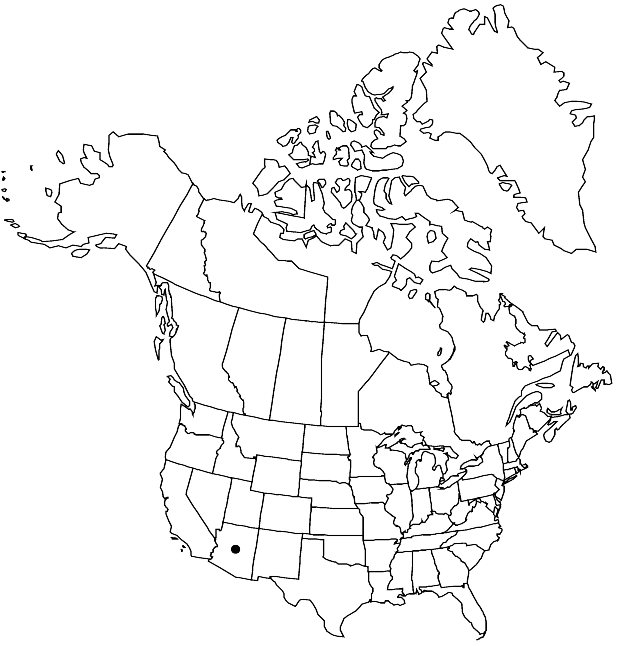Difference between revisions of "Draba bifurcata"
Harvard Pap. Bot. 12: 411. 2007.
FNA>Volume Importer |
imported>Volume Importer |
||
| (6 intermediate revisions by 2 users not shown) | |||
| Line 7: | Line 7: | ||
|year=2007 | |year=2007 | ||
}} | }} | ||
| − | |basionyms={{Treatment/ID/ | + | |basionyms={{Treatment/ID/Basionym |
|name=Draba helleriana var. bifurcata | |name=Draba helleriana var. bifurcata | ||
|authority=C. L. Hitchcock | |authority=C. L. Hitchcock | ||
| + | |rank=variety | ||
| + | |publication_title=Revis. Drabas W. N. Amer., | ||
| + | |publication_place=39, plate 3, fig. 21e. 1941 | ||
}} | }} | ||
|synonyms= | |synonyms= | ||
| Line 26: | Line 29: | ||
|elevation=1800-3600 m | |elevation=1800-3600 m | ||
|distribution=Ariz. | |distribution=Ariz. | ||
| − | |discussion=<p>Draba bifurcata is distinguished from other North American species by a combination of yellow flowers with styles (1–)2–3 mm and almost exclusively simple trichomes on the abaxial surface of cauline leaf blades. It is known only from Chiricahua, Santa Catalina, and White mountains in Apache, Cochise, and Pima counties.</p> | + | |discussion=<p><i>Draba bifurcata</i> is distinguished from other North American species by a combination of yellow flowers with styles (1–)2–3 mm and almost exclusively simple trichomes on the abaxial surface of cauline leaf blades. It is known only from Chiricahua, Santa Catalina, and White mountains in Apache, Cochise, and Pima counties.</p> |
|tables= | |tables= | ||
|references= | |references= | ||
| Line 35: | Line 38: | ||
-->{{#Taxon: | -->{{#Taxon: | ||
name=Draba bifurcata | name=Draba bifurcata | ||
| − | |||
|authority=(C. L. Hitchcock) Al-Shehbaz & Windham | |authority=(C. L. Hitchcock) Al-Shehbaz & Windham | ||
|rank=species | |rank=species | ||
| Line 50: | Line 52: | ||
|publication year=2007 | |publication year=2007 | ||
|special status= | |special status= | ||
| − | |source xml=https:// | + | |source xml=https://bitbucket.org/aafc-mbb/fna-data-curation/src/2e0870ddd59836b60bcf96646a41e87ea5a5943a/coarse_grained_fna_xml/V7/V7_378.xml |
|tribe=Brassicaceae tribe Arabideae | |tribe=Brassicaceae tribe Arabideae | ||
|genus=Draba | |genus=Draba | ||
Latest revision as of 22:33, 5 November 2020
Biennials or, rarely, perennials; caudex simple or branched; not scapose. Stems branched or unbranched, 1–3.9 dm, pubescent throughout or proximally, trichomes simple, 0.3–1.4 mm, often with smaller, 2 (or 3)-rayed ones. Basal leaves (soon withered); rosulate; petiolate; petiole ciliate, (trichomes simple, 0.4–1.1 mm); blade oblanceolate to spatulate, 1–7 cm × 2–12(–26) mm, margins entire or dentate (pubescent as petiole), surfaces pubescent, abaxially with simple trichomes, 0.6–1.1 mm, and stalked, 2- (or 3-)rayed ones, often smaller, adaxially with subsetiform, simple trichomes, 0.5–1.2 mm (rarely with fewer, stalked, 2-rayed ones). Cauline leaves (2–)6–15; sessile; blade lanceolate to ovate or oblong, margins dentate, surfaces pubescent as basal. Racemes 10–51-flowered, ebracteate, elongated in fruit; rachis glabrous or pubescent as stem, not flexuous. Fruiting pedicels horizontal to divaricate, straight, 4–15 mm, glabrous or pubescent, trichomes simple and 2-rayed. Flowers: sepals ovate, 2.5–3.2 mm, pubescent, (trichomes simple and short-stalked, 2-rayed); petals yellow, oblanceolate, 4.5–6.5 × 1.5–2 mm; anthers oblong, 0.8–1.1 mm. Fruits elliptic-lanceolate, twisted (1 turn or plane), flattened, 6–10 × 2–2.5 mm; valves glabrous or sparsely puberulent, trichomes simple, 0.05–0.15 mm; ovules 14–20 per ovary; style (1–)2–3 mm. Seeds oblong, 1.1–1.4 × 0.7–0.9 mm.
Phenology: Flowering Jun–Jul.
Habitat: Rocky areas, damp shady ravines, aspen-spruce communities
Elevation: 1800-3600 m
Discussion
Draba bifurcata is distinguished from other North American species by a combination of yellow flowers with styles (1–)2–3 mm and almost exclusively simple trichomes on the abaxial surface of cauline leaf blades. It is known only from Chiricahua, Santa Catalina, and White mountains in Apache, Cochise, and Pima counties.
Selected References
None.
